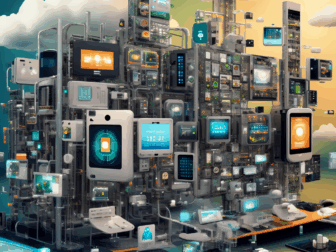Tag - 5G & IoT
Blog , November 21, 2023 , 5G & IoT, 5G Technology and IoT, internet of things
Unleashing the Potential of Smart Devices: How 5G Revolutionizes the Internet of Things (IoT) Ecosystem
Unleashing the Potential of Smart Devices: How 5G Revolutionizes the Internet of Things (IoT) Ecosystem
The advent of 5G technology heralds a new era in the field of communication and connectivity. With its ultra-fast speeds, low latency, and increased capacity, 5G is set to revolutionize how we interact with the world around us, particularly through the Internet of Things (IoT). IoT, which refers to the interconnection of everyday objects via the internet, has the potential to transform our lives by making our environments smarter and more responsive.
One of the most significant advantages of 5G in the context of IoT is its high data transfer rate. The increased bandwidth allows for more devices to be connected with higher reliability, ensuring smooth communication between a vast array of smart devices. This is essential for collecting, transmitting, and processing data in real-time, which is critical for applications that require immediate responses, such as autonomous vehicles and remote surgery.
Another critical aspect of 5G is its remarkably low latency. Latency refers to the delay before a transfer of data begins following an instruction. 5G’s low latency is a game-changer for IoT applications that depend on instantaneous, almost real-time interaction, such as industrial automation, where machines need to communicate with each other with minimal delay to ensure efficient production processes.
Additionally, 5G is designed to support a massive number of devices in a small area without the network getting congested. This feature is particularly important in urban environments where countless IoT devices, such as sensors and cameras, need to operate simultaneously. With 5G, cities can become smarter and more efficient, leveraging IoT to manage traffic, monitor environmental conditions, and improve public services.
The energy efficiency of 5G also plays a crucial role in the expansion of IoT. Many IoT devices need to be small and run on battery power for extended periods. 5G networks are engineered to provide low-power options for these types of devices, extending their battery life and reducing the need for frequent maintenance or recharging.
One of the most exciting developments enabled by the combination of 5G and IoT is the concept of the smart home. With higher-speed 5G connections, smart home devices can communicate and make decisions faster than ever before, creating a seamless and intuitive living environment. Whether it’s adjusting the thermostat, managing lighting, or ensuring home security, 5G-IoT integration is making homes more intelligent and responsive to the needs of their inhabitants.
In the industrial sector, the impact of 5G-IoT integration is equally profound. Known as the Industrial Internet of Things (IIoT), this synergy allows for unparalleled levels of automation and optimization. Factories and plants can monitor equipment performance in real-time, predict maintenance needs, and streamline supply chains, ultimately leading to increased productivity and reduced operational costs.
To fully realize the potential of 5G and IoT, however, challenges such as security and privacy concerns must be addressed. As the number of connected devices grows exponentially, so does the potential attack surface for cyber threats. Ensuring robust security protocols and safeguarding personal data are essential steps towards fostering trust and encouraging widespread adoption of these technologies.
In conclusion, the convergence of 5G and IoT is set to bring about a transformation in how we live and work. By providing the backbone for a more connected and intelligent world, 5G will enable the full potential of IoT to be unleashed, resulting in greater efficiency, convenience, and quality of life. As we move forward, it is clear that this powerful combination will continue to drive innovation and open up new possibilities for the future.
